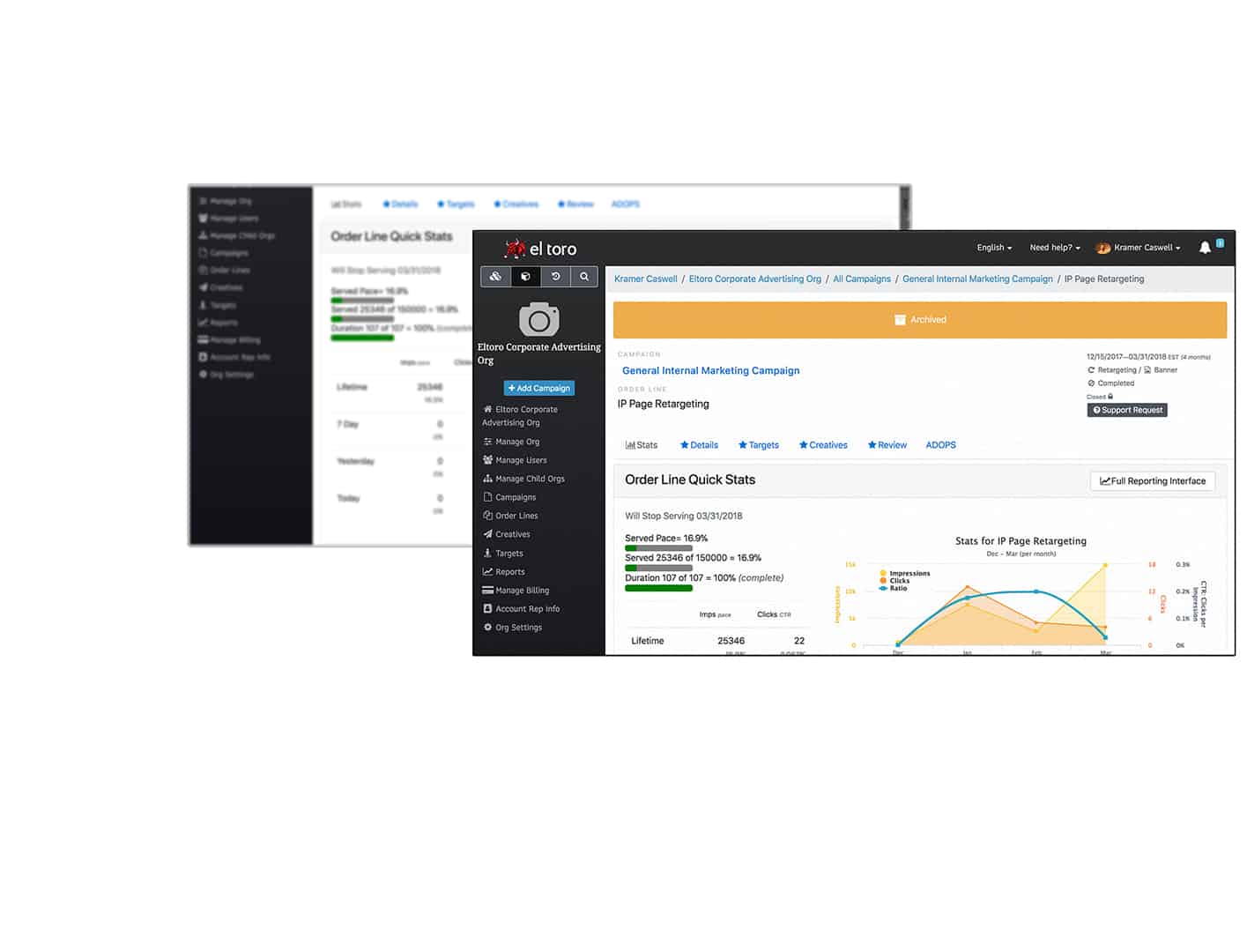blog
Advertising Metrics
How El Toro Measures Advertising Metrics
 If you’re looking for advertising metrics on behalf of your brand, odds are you’re most likely looking for one key end result, profit, regardless if it be money, or a gain or advantage, or even furthering your brand recognition. Whether you’re a nonprofit looking for donations, a new business looking for leads, a local repairman looking for more clients, a national auto brand looking for additional car sales, or even a political candidate looking for votes, most everyone is seeking a profit - monetary or not.
If you’re looking for advertising metrics on behalf of your brand, odds are you’re most likely looking for one key end result, profit, regardless if it be money, or a gain or advantage, or even furthering your brand recognition. Whether you’re a nonprofit looking for donations, a new business looking for leads, a local repairman looking for more clients, a national auto brand looking for additional car sales, or even a political candidate looking for votes, most everyone is seeking a profit - monetary or not.
When analyzing the success of an advertising campaign, most agencies and platforms utilize the same metrics. The ad jargon used to show the outcome of an ad campaign can get a little distorted with so many numbers thrown together.
Another flaw of advertising metrics is that not a lot of agencies and platforms are linear on the terms they use to define the success of an ad campaign. This can make things a bit messy when trying to fully understand just how well your ad campaign performed.
Perhaps the biggest pitfall of the ad industry is the overuse and/or misuse of advertising metrics. This mishap can delude clients into not knowing the actual, hard metric of the success of their campaign.
That’s why here at El Toro, we take the mess out of advertising metrics and just give you the numbers you need to know.
Advertising Metrics Within Our Ad Portal

Impressions: An impression translates to an ad being served on a site, ad served meaning your ad that was placed on a site. Therefore when an ad is fully loaded and set onto a site, it counts as a single impression.
CPM: CPM technically stands for ‘cost per mille’, in Latin, French and Italian, mille means one thousand, translating to cost per thousand. In this case, the CPM is the cost per thousand impressions. Therefore, a complete understanding of CPM is the cost per thousand ads served.
Ordered Impressions: Ordered impressions is how our clients select a budget for their campaign. Prior to launching your campaign through El Toro, you’ll select how many thousand impressions you want to serve across the duration of your campaign. We use ordered impressions as a way to charge our clients for their advertising campaign, using the above-discussed CPM to do this per thousand impressions.
Served Impressions: While you order a set number of impressions, it’s on us and our technology to make sure your campaign serves as close to that ordered number as possible. With how quickly our programmatic advertising buying takes place, even with constant monitoring campaigns tend to go a little over or under on the number of ordered impressions. Served impressions are the actual number of impressions that your campaign executed across its duration. This usually produces within a few hundred impressions of how many were originally ordered. Given that we charge based on CPM, this results in a very menial amount of cost difference in budget spent.
Clicks: This may seem a little self-explanatory, but believe it or not we still get questions on this. It’s as plain and simple as you think, clicks are the number of people that clicked on your served ad. It’s really easy to get caught up in ad clicks, however, while this is an important metric to some degree, it’s just one step in the process of fully securing a conversion.
CTR: CTR stands for ‘click-through rate’. You can measure the CTR of a campaign by taking the number of clicks and dividing that by the number of served impressions, showing the rate of which your ad was clicked per the number of times it was served. There are some pros to looking at CTR in regards to your campaign’s performance. We utilize CTR as a way of making sure everything is running smoothly during the extent of the campaign being live. If we notice a below normal CTR we may go in and evaluate some of the aspects of your campaign, such as your creatives, your messaging, your landing page, etc., all to make sure your campaign has what it needs in place to succeed.
Records: This number represents the full scope of people we could target with your ads. Whether you imported your CRM list, or you used our Digital New Movers to target a zip code to find recent movers, or perhaps you used our Venue Replay to target people at a point of interest, etc., the ‘records’ are the full number of people either in your list or the area we have chosen to target. Note that this is the number of consumers present before we execute our IP address matching, While this embodies the full group at hand, this is only our number of potential targets to hit. Therefore this is those we aim to match with IP addresses and target through our patented IP matching algorithm.
Matched Targets: Once we run our IP matching technology, we can then decipher those who we are able to target with 95% or above accuracy. This is the number of above records that are now narrowed down to actual targets. These matched targets are those whom El Toro is able to take and pull IP addresses for, enabling us to then be able to deliver them digital ads. El Toro has a patented process that takes data points from over 30 different sources to match people to their correlating IP address.
 Advertising Metrics With Our MatchBacks
Advertising Metrics With Our MatchBacks
MatchBacks are what makes El Toro’s technology proven in its abilities. We use our Matchbacks to show you the after results and straightforward success of your ad campaign. These are typically sent to our clients within two weeks of the closure of their campaign. To get a hard count on how well the advertising metrics and the overall campaign went, you provide us with your sales reports for the duration of your ad campaign and we provide the numbers and metrics from the advertisements. We then compare sales data against those whom we targeted, to show you your true return.
To ensure that our MatchBacks are 100% clear and self-evident, we cut out as much jargon as we can. This enables us to provide you with the only information necessary to know if your ad dollars spent through our technology worked successfully for you.
***Our MatchBack advertising metrics are broken into two different sections for comparison, a target group and a control group. The target group represents the matched targets discussed above, those that we were able to match IP addresses on, and therefore were able to serve digital ads. On the other hand, the control group is those who we were not able to get IP addresses on and did not serve digital ads.
We do this for 100% transparency so you can see a comparison between those who we targeted versus those who we did not. Through this, our clients can see the all-encompassing effectiveness of utilizing our technology.
Append: The append section of our MatchBack reflects the total number of people in each group, pertaining to both the target group and the control group.
Percent of Append: This represents the percentage that each group, both target and control, represents in regards to the total number of overall targets. This can be calculated by dividing the group number of records by the total number of targets.
Total Sales: Total sales represents the income received per group. To get this (as stated above), our clients provide us with their sales data, providing addresses with sales to enable proper matching. We can then take this sales data and compare it with each append group. From here, we can calculate the number of sales that should be attributed to both the target group and the control group, showing how much in sales each group accounted for.
Conversions: Conversions is one of the most essential advertising metrics in our MatchBacks. The conversions represent the number of people that clicked through and converted completely, carrying out whatever action was aimed for from ad campaign. Whether you’re trying to sell cars, looking for donations, looking for new clients, any desired outcome, the conversions section of your MatchBack will reflect the number of people who accomplished your desired result. It goes without saying, high conversions is what we strive for!
Conversion Percent: This is a prime way we make evident to our clients how successful their campaign was, comparing sales data between those we targeted versus those we did not. The conversion percentage shows what percent of the conversions came from the target group versus those that came from the control group. This can be calculated by dividing a group’s conversions by the total number of conversions. This gives you a side by side comparison of how many of the target group converted against how many of the control group converted.
Conversion Rate: This is the percentage of how many people from each group converted. Interestingly, our typical conversion rate is even higher than most advertising platform’s CTR. The conversion rate is our way of showing the success of a campaign rather than CTR, as most platforms do. To calculate, take the number of conversions per group and divide that by the number of appends in that group.
Improvement: The improvement rate is where you can directly see how well our technology works. This metric provides you with a hard comparison number reflecting just how well your target group responded to ads compared to your control group who did not receive digital ads.
The improvement metric takes the conversion rate of both groups and compares to show how much of a lift there was in the target group compared to the control group. This can be calculated by subtracting the target group conversion rate by the control group conversion rate, from there you can divide that number by the control group conversion rate.
This makes it transparent showing the percentage difference between the two groups, showing the lift and therefore improvement among those who received digital ads, targeted through our technology.
ROAS: ROAS stands for ‘return on advertising spending’. ROAS is a fantastic way to show the overall success of an ad campaign. ROAS can be calculated by taking the revenue generated from a campaign and dividing that by the number of dollars spent on that ad campaign. This shows you a full dollar for dollar return on your advertising spending. We continue to see unbelievable ROAS metrics. Even within 2018 alone, we’ve seen impressive returns ranging across the board, some as high $100 earned for every $1 spent.
Advertising Metrics Outside of El Toro

Reach: The overall meaning of reach when referring to an ad campaign is the number of unique people or households who will be likely exposed to the medium your ad is placed on, and will most likely see your ad at least once. This does not represent the number of times your ad was fully seen. Rather, reach represents the unique users that were exposed to your ad at least once. This is different from impressions in that impressions can be served to the same person multiple times, however, the reach only accounts for each person a single time once they’ve viewed the ad. Often this is used to convey the value of exposure. Reach is not something El Toro has to worry about as we go into our campaigns knowing specifically how many consumers and what specific users we will be targeting.
CPC: CPC refers to ‘cost per click’ on an ad campaign. This tends to seem beneficial, given that anyone executing a digital ad campaign obviously wants clicks. It aids to encourage this as a lot of ad platforms make use of this to give an overall assessment of a campaign.
In reality, CPC does not take into measure what happens after someone clicks on an ad, or how long they’re on your site after clicking, or even whether they converted. This means if someone accidentally clicks on your ad, typically seen on mobile app ad placement, or if your ad was clicked by nonhuman traffic, typically seen in cookie-based advertising metrics, these still factor into your CPC as a successful click.
Engagement rate: Social media is an advertising metrics bubble all on its own. The overall number we see used to encompass social media as involvements are known as the engagement rate. Engagement can refer to any type of interaction with an ad from consumers. This can include likes, comments, shares, changing the volume on a video, clicking through an image wheel, etc.
Social media ad platforms emphasize engagement rates as a way to show their advertisers how well their ad is performing. Here’s the kicker though, it doesn’t mean anything to your company’s profits or conversions if your ad got a ton of ‘likes’ or comments or shares.
Don’t get us wrong, we believe social media is phenomenal for brand awareness and affirmation, but for the point of sales and conversions, we find it to be a futile effort. Too often we find that people get caught up advertising metrics on social media and the engagement rates that come with that. If at the end of the day your advertising isn’t driving profit, sales, or conversions, then it has been effort in vain.
CTR: As mentioned above, El Toro does make use of CTR and does share this with our clients, however, our use is much different than most platforms. Much like CPC, CTR is perhaps the most overly emphasized metric in showing outcoming of ad campaigns. Here at El Toro, we strongly make an effort to debunk this, at least in regards to showing the success of a campaign. It very much so goes along with the distorted CPC mentality. CTR simply takes into account every click, regardless of the outcome of that click or the credibility behind who/what made that click. We see too many platforms evaluating their campaigns by CTR, claiming high CTR rates as a measurement of success. In reality, this metric does not show the gain from your investment. El Toro’s technology takes all fraud and flaw out of our ad targeting. With this, we know that every click received on your ad was that of a real, targeted consumer, no bots, no fraud.
In Summary
Take into account what advertising metrics your advertising agency is providing you. Metrics are important to have at the end of your campaign to know how the as the campaign went. With that as well, we find it is beneficial to our clients to have advertising metrics to view while their campaign is live, which is available through our portal. This allows our clients to recognize whether performance is where they want it to be before the campaign ends. From here changes or improvements can be made along the way for improvements. In the end, it is crucial to have the advertising metrics you need, allowing you to know if you’re spending your marketing budget properly.
Ready to Run With the Bull?
Contact Us
 Advertising Metrics With Our MatchBacks
Advertising Metrics With Our MatchBacks



